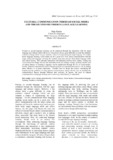| dc.contributor.author | Nasrin, Nipa | |
| dc.date.accessioned | 2013-06-12T06:34:59Z | |
| dc.date.available | 2013-06-12T06:34:59Z | |
| dc.date.issued | 2012 | |
| dc.identifier.uri | http://hdl.handle.net/10361/2604 | |
| dc.description.abstract | Foreign or second language learning can be enhanced through the interaction with the target
language and cultural context. However, it has always been a great difficulty to create the authentic
cultural exchange which can give students a chance of experiencing the target language. For culture
based language learning, social media can be a great tool. First, direct communication with the
target culture and language will keep the students motivated and give them better language skills
and critical literacy. This authentic interaction will ultimately increase their reading, writing and
sociocultural knowledge. Second, the interrelation between reading, writing, speaking and the need
of critical literacy in learning a language can be emphasized through the use of social medias.
Finally, different content-based email or internet projects are important but teachers’ role in making
those effective is of prime importance. Teachers have to design the courses considering the
benefits and the problems of using internet communication, along with the ways to facilitate the
cultural/critical literacy through different later activities. In general, the need of cultural
communication in language learning and in achieving critical literacy is undeniable. | en_US |
| dc.language.iso | en | en_US |
| dc.publisher | BRAC University | en_US |
| dc.relation.ispartofseries | BRAC University Journal, BRAC University;Vol. 9, No. 1 & 2, 2012, p. 57-61 | |
| dc.subject | Socio-cultural apprenticeship | en_US |
| dc.subject | Critical literacy | en_US |
| dc.subject | Social media | en_US |
| dc.subject | Contextualized language learning | en_US |
| dc.subject | Teachers as facilitators | en_US |
| dc.title | Cultural communication through social media and the second or foreign language lerning | en_US |
| dc.type | Article | en_US |

